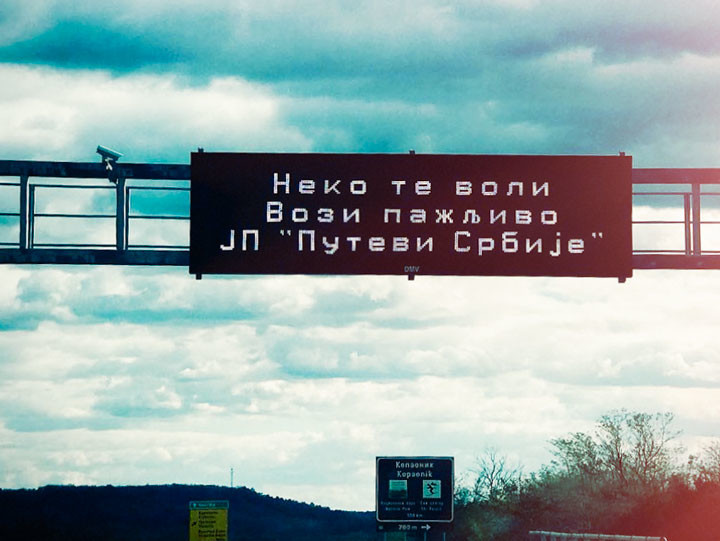Is Europe Really That Far Away?

If we are to speak about Digital Signage technology, than the encouraging fact is that Serbia is not seriously falling behind its close or many distant European neighbors.
Whenever some new technological advancement is mentioned in a conversation, we usually come to one universal conclusion: the World, whatever in that moment we consider it to be, reached the level that we as a country are yet to reach. The differences are generally big and very obvious.
Fortunately for us, there are areas where it is not always and without exception the case.
If we are to speak about Digital Signage technology, than the encouraging fact is that Serbia is not seriously falling behind its close or many distant European neighbors.
One of mine recent journeys though Europe has proved to me exactly this – as a country we are on the right track with our goal clearly visible on the horizon. Surely, some countries took the lead in developing and implementing this technology. These are bright examples that we need to follow. One of the most meaningful and functional public uses I have seen is the traffic regulation system in Monte Carlo.
Given that it is a small city with very dense traffic and a large number of different events held throughout the year, the flow of vehicles must be dynamically regulated in order to function smoothly.
What is the role of Digital Signage here?
Using interactive screens, the direction of the streets, the redirection system and other road signs change according to the time of the day and current traffic situation. The use of the displays becomes especially important if you take into account that a large part of the road network is underground and regulated by roundabouts.

In other areas of Digital Signage technology usage, life in Europe does not differ much from life in Serbia. That being said, hypermarkets are fully equipped with electronic shelf labeling system so there is no need to print prices on the paper. In addition to increasing the accuracy of the stated prices and providing better tracking, this system reduces the time and work needed for their update and changes.
Somewhere around this point, every difference between Europe and us, regarding the use of LED screens in retail vanishes. Supermarkets are not equipped with a large number of interactive screens and there is no indication there will be serious changes regarding this in near future. Some individual shops may be taking a step further, but the full coverage of shopping centers with Digital Signage for example or usage of interactive mirrors and dressing rooms, which I have written about in the previous text, still is far from being reality.
Whether Europe is straggling behind Japan or America is another matter to be discussed. I rather prefer to think that we do not lag behind the possibilities that technology offers.
For sure, all across Europe there is a significant awareness of the benefits Digital Signage is offering, but it is mostly focused on public and social services. Much more than on marketing.
In this light, apart from traffic regulation in Monte Carlo, good example is definitely the coverage of public transport and metro lines in France with this technology.
Additionally, the most obvious use of digital screens In Europe is an information distribution system installed on many highways regarding road conditions, traffic jams, accidents, waiting times and weather conditions.
Digital Signage, in this form, realizes its full purpose when it comes to public services. Behind the notification system there must be certain software solutions, but even that does not automatically mean we are talking about large investments in development and maintenance. Information can be provided using Google Traffic, which can collect real-time data on road conditions, sensors measuring different weather conditions, cameras that measure density and flow of traffic as well as information received from road police and emergency assistance in case of accidents. Screens, both immobile and those mounted on special cars for information purposes, are thus helping drivers and directing traffic to less congested sections.
We have developed infrastructure for this. We only need to employ it.
Digital Signage also has many possible applications around the cities. Through interactive displays it is possible to provide information to passers-by about the near future weather changes, current temperature, wind and rain expectations, traffic jams, outdoor events or protests. All this in real time and localized by different parts of the city. Again, this can be enabled thanks to the aforementioned Google Traffic and other installed sensors. Such system can help people in choosing where they want or where they should go, while taxi drivers, ambulance and other public services when choosing the shortest route for reaching intended locations.
This is not the ultimate reach of utilizing collected information. They can also be used to meet certain commercial goals, both at the level of the city and individual companies and organizations. It is a smart city concept that we want to become a synonym for Belgrade and Serbia in the next ten years.
In accordance with the tendency to develop into part of our everyday life in the near future, Saga worked on Transport Intelligent Network Assistant project in collaboration with FON, linking achievements in the field of artificial intelligence, Chatbot, IoT and Digital Signage. The results have shown that solutions based on the integral use of different technologies can provide really a lot in the most diverse areas.
For example, such an integral solution could, in addition to booking the hotel, offer tourists and visitors an organization of their entire stay in our city and country.
How would it work?
If someone planned to visit Ada, and the day he choose to do this is not really promising a good weather, this application could offer him an alternative visit to the museum or some other appropriate activity.
Artificial Intelligence, as part of this solution, would provide a logic to process information and offer users an appropriate alternative, chosen according to their previously shown preferences. Chatbot will be there to communicate to users all selected options. With this, users stay with an impression that someone took care of them while they were visiting and would leave the city with a good feeling and great personal experience.
Such a system can help different public and private entities in the city to advertise their services and become more accessible to potential visitors. Targeted redirection can increase visitation of different locations and thus optimize the utilization of the existing tourist offer.
Perhaps now all this sounds like a distant future, but in order to do things today, we have to look where we want to get to. On the other hand, in order to arrive there, we have to do things today.
How far is Europe and European companies when we talk about the possibilities of creating such solutions?
Exactly where we are. With the knowledge, experience and quality of work force we have in the field of intelligent systems, IoT and Digital Signage we are in a good position and in an excellent moment to enter the competition. With the timely creation of comprehensive solutions, our future and the future of our European neighbors will be made closer and more accessible.
Zayn Malik[/kswr_iconboxinfo]
